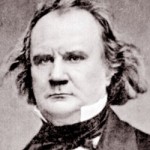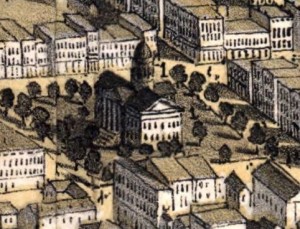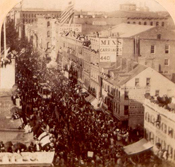 This section of the “History of the Atlantic Cable & Undersea Communications” website is a great resource on the first transatlantic cable in 1858. The site offers lots of information, but the best are the transcripts and images from publications such as Frank Leslie’s Illustrated Newspaper. Newspapers provided readers in 1858 with detailed accounts on the progress of the cable’s construction and the celebrations that took place in cities after the first official message was sent. “Wherever the news penetrated there was a public jubilee” and, according to the Illustrated London News, “the most thorough and systematic display of popular joy took place” in New York City. While the cable stopped working after only a few days, it marked an important first step.
This section of the “History of the Atlantic Cable & Undersea Communications” website is a great resource on the first transatlantic cable in 1858. The site offers lots of information, but the best are the transcripts and images from publications such as Frank Leslie’s Illustrated Newspaper. Newspapers provided readers in 1858 with detailed accounts on the progress of the cable’s construction and the celebrations that took place in cities after the first official message was sent. “Wherever the news penetrated there was a public jubilee” and, according to the Illustrated London News, “the most thorough and systematic display of popular joy took place” in New York City. While the cable stopped working after only a few days, it marked an important first step.
23
Nov
09
Transatlantic Telegraph
Posted by sailerd Published in Antebellum (1840-1861), Historic Periodicals, Images Themes: Business & Industry, Science & Technology, US & the World16
Nov
09
Harpers Ferry – Mason Committee
Posted by sailerd Published in Antebellum (1840-1861), Historic Periodicals Themes: Slavery & AbolitionAfter John Brown’s attack in October 1859 on the federal arsenal in Harpers Ferry, Virginia, the United States Senate launched an investigation that became known as the Mason Committee. Yet when this committee released its findings in the summer of 1860, many regarded its efforts as ineffective. “Supporters of both sides were…heavily armed” in the visitor galleries of Congress and, as historian David Reynolds explains, “the Mason Committee knew it had to handle the Harpers Ferry matter with kid gloves.” House Divided has some material available on this committee, including an editorial originally published in the Ohio State Journal. This paper summed up the problem with the investigation in a single sentence – “The man who knew every thing was not summoned, and the man [who] knew nothing was imprisoned.”
3
Nov
09
Filibustering
Posted by sailerd Published in Antebellum (1840-1861), Historic Periodicals, Images Themes: US & the World
Most students are unfamiliar with the Filibuster of the 1850s. If anything, one associates it with attempts to prevent a vote on bills in the US Senate. T. J. Stiles’ essay in the Gilder Lehrman’s online journal History Now provides a nice overview of the subject and profiles the infamous “Filibuster King” William Walker. “Filibusters were independent adventurers who launched freelance invasions of foreign countries” and most planned “to annex them to the United States,” as Stiles explains. Walker’s actions violated the US Neutrality Act, but he always believed that he was “destined to create a central American empire.” One of Walker’s targets was Nicaragua, which he invaded in 1855 and was later forced out by May 1857. While Stiles discusses this invasion, another short essay provides images from Frank Leslie’s Illustrated Newspaper. House Divided also has material on this topic, including more primary sources related to Walker and other filibusters like John A. Quitman.
23
Oct
09
Election of 1860 – Political Appointments
Posted by sailerd Published in Antebellum (1840-1861), Historic Periodicals, Letters & Diaries Themes: Contests & ElectionsAfter his victory in the 1860 election, President-Elect Abraham Lincoln quickly started to work on filling the positions in the federal government that were political appointments. While selecting cabinet members was an important task, historian Harold Holzer explains that “Lincoln understood” how critical it was “to purge [the] Democrats” and “guarantee the loyalty of the federal bureaucracy.” Even as Lincoln considered the appropriate response to the secession crisis, he held countless meetings with office seekers who showed up at his temporary office in the Illinois Statehouse (see image to the right – it is #1 on this map). Those unable to travel to Springfield sent numerous letters to recommend either themselves or their friends. Other letters offered Lincoln advice on the appointment process. “Do not be led astray by corrupt Politicians,” as one anonymous author warned. The significant amount of incoming mail even caught the eye of at least one reporter. After a meeting in December, the reporter’s only comment about Lincoln’s office was to note that “[the secretary’s] desk [was] heaped up with letters and documents.” The political activity in Springfield did not escape the notice of Democratic papers like the New York Herald, which used the opportunity to portray their rivals as corrupt. The Herald predicted a “great republican feast” on all “the fat things” and identified the two “cooks” who would direct “the distribution of federal offices” in Pennsylvania.
21
Oct
09
Harpers Ferry – Fugitives in PA
Posted by sailerd Published in Antebellum (1840-1861), Historic Periodicals, Images Themes: Slavery & Abolition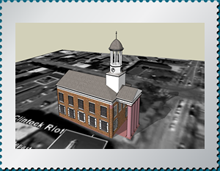
The Harpers Ferry story does not end when John Brown was captured early in the morning on October 18, 1859. While five members of his group managed to escape (including Barclay Coppoc, who later served in the Union army), others were not as fortunate. Albert Hazlett and John Edwin Cook, who were traveling separately, were both arrested in Pennsylvania. Hazlett was captured on October 22 and sent to Carlisle. (House Divided has a 3D model of the courthouse where his extradition hearing took place). Cook was captured four days later in Franklin County. Both men were sent back to Virginia, where after short trials, they were sentenced to death. The story attracted national attention and reports were published in papers around the country, including from Illinois, Ohio, and Kansas. These reports, however, were not always accurate. The Cleveland Herald explained that someone who “[gave] his name as Wm. Harrison” was “arrested…on the suspicion that he was Capt. Cook.” William Harrison was actually the name that Hazlett used after his arrest. One can also follow the story in papers published in central Pennsylvania. The Valley of the Shadow has two papers from Franklin County – the Franklin Repository and the Valley Spirit. Pennsylvania Civil War Newspapers also has a number of options, including the Gettysburg Compiler and the Lancaster Intelligencer.
19
Oct
09
Harpers Ferry – "Good Out of Evil"
Posted by sailerd Published in Antebellum (1840-1861), Historic Periodicals Themes: Slavery & Abolition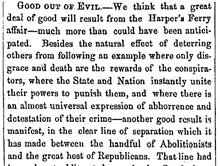
Last week I discussed a southern newspaper that argued that only legal means should be used against abolitionists who threatened southern communities. Immediately after the Harpers Ferry Raid, however, this newspaper had a different perspective. The editor was not concerned about abolitionists invading the South, but rather argued in late October 1859 that Harpers Ferry would actually reduce sectional tensions. “We think that a great deal of good will result from the Harper’s Ferry affair – much more than could have been anticipated,” as the Fayetteville Observer explained. Only “fanatics” in the North supported Brown’s raid. The Observer also argued that Harpers Ferry would split the Republican party. An editorial in an Indiana newspaper was one of “many…signs of conservative Republicans [who were] cutting loose from the ultra fragments of their party.” While the Observer later admitted that Brown’s raid had not “heal[ed] the sectional breach,” it is still important to consider this newspaper’s initial reaction.
13
Oct
09
Impact and Development of Railroads in the North and South
Posted by Published in Antebellum (1840-1861), Historic Periodicals, Lesson Plans, Letters & Diaries, Maps Themes: Business & Industry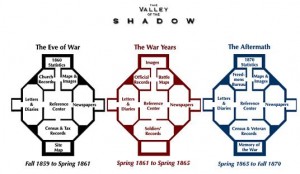
Though previously mentioned in another post, the The Valley of the Shadow Project has a wide range of primary sources from newspapers, maps, letters, and statistics all available for use in the 7-12 classroom. Broken up chronologically into three periods, the Project archives two communities (Augusta County, Virginia and Franklin County, Pennsylvania) between the years of 1859 and 1870. A particularly good lesson plan by Alice Carter compares the impact and the development of the railroads in both counties using various articles from historical newspapers. The lesson provides a teacher with preselected articles, however, one may choose to either find newspaper accounts that reflect individual class interests or allow students to search for their own, using the newspaper indexes. One special note: teachers could extend the lesson and explore the impact of railroads during reconstruction.
7
Oct
09
Harpers Ferry – Southern Reaction
Posted by sailerd Published in Antebellum (1840-1861), Historic Periodicals Themes: Slavery & Abolition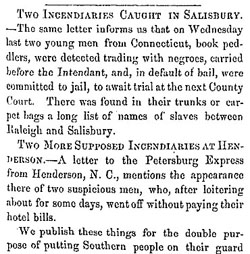 The South’s reaction to John Brown’s attack is often characterized as a violent one. “The shock and fear John Brown had instigated fueled widespread panic…[that] fed into paranoia vented in aggressive acts,” as historian David Reynolds explains. Yet not all southerners accepted violent actions. Protecting their communities remained a high priority, but these southerners argued that extralegal means should not be employed. Not only were existing laws more than sufficient, but violent actions impugned southern honor. Someone who “was tarred and feathered” “for sympathsing [sic] with old Brown” may have “richly deserved his punishment,” but the Greensboro Patriot argued that the best solution was “to let the law take its course.” Other editors in North Carolina reached similar conclusions. “The laws are ample to protect the South,” as the Fayetteville Observer explained in November 1859. The Observer later implied that southern honor was at stake: “in some places the prejudice against Northern men has been carried to an extent at once injurious to the interests and disgraceful to the character of the South.” Brown attacked Harpers Ferry 150 years ago, but as historian William Freehling observers, we still have much to learn about the “subtleties of the southern response.”
The South’s reaction to John Brown’s attack is often characterized as a violent one. “The shock and fear John Brown had instigated fueled widespread panic…[that] fed into paranoia vented in aggressive acts,” as historian David Reynolds explains. Yet not all southerners accepted violent actions. Protecting their communities remained a high priority, but these southerners argued that extralegal means should not be employed. Not only were existing laws more than sufficient, but violent actions impugned southern honor. Someone who “was tarred and feathered” “for sympathsing [sic] with old Brown” may have “richly deserved his punishment,” but the Greensboro Patriot argued that the best solution was “to let the law take its course.” Other editors in North Carolina reached similar conclusions. “The laws are ample to protect the South,” as the Fayetteville Observer explained in November 1859. The Observer later implied that southern honor was at stake: “in some places the prejudice against Northern men has been carried to an extent at once injurious to the interests and disgraceful to the character of the South.” Brown attacked Harpers Ferry 150 years ago, but as historian William Freehling observers, we still have much to learn about the “subtleties of the southern response.”
21
Aug
09
Illinois Periodicals Online
Posted by sailerd Published in 19th Century (1840-1880), Historic Periodicals, Images, Lesson Plans Themes: Settlers & Immigrants The Northern Illinois University offers digital access to a number of different publications. Nine magazines are available from the Illinois Periodicals Online, such as Illinois Heritage (1997-2007). Teachers may want to check out Illinois History Teacher (1994-2009). Each article provides suggestions on how to use it in your classroom. For example, take a look at “Yankees and Southerners Clash in Frontier Illinois” by James E. Davis and the accompanying curriculum materials. In addition, some of the magazines are appropriate for younger readers (see Illinois History).
The Northern Illinois University offers digital access to a number of different publications. Nine magazines are available from the Illinois Periodicals Online, such as Illinois Heritage (1997-2007). Teachers may want to check out Illinois History Teacher (1994-2009). Each article provides suggestions on how to use it in your classroom. For example, take a look at “Yankees and Southerners Clash in Frontier Illinois” by James E. Davis and the accompanying curriculum materials. In addition, some of the magazines are appropriate for younger readers (see Illinois History).
Teachers can also access the Journal of the Illinois State Historical Society (1979-2006) through NIU’s Illinois Historical Digitization Project.
29
Apr
09
“Naval Officers and their Uniform”
Posted by sailerd Published in Antebellum (1840-1861), Historic Periodicals Themes: Battles & Soldiers, Education & Culture To see naval officers in uniform walking around New York city in 2009 is unremarkable. Yet in November 1859 a lieutenant wrote the New York Herald to address the fact “that a great number of naval officers are seen daily in the streets and public places in uniform.” While careful to note that he was not “ashamed of [his] uniform,” this officer believed such public display was wrong. “In our republican country,” as he explained, “it is not customary for offices of either “arm of national defense” to war their uniforms, save on special occasions.”
To see naval officers in uniform walking around New York city in 2009 is unremarkable. Yet in November 1859 a lieutenant wrote the New York Herald to address the fact “that a great number of naval officers are seen daily in the streets and public places in uniform.” While careful to note that he was not “ashamed of [his] uniform,” this officer believed such public display was wrong. “In our republican country,” as he explained, “it is not customary for offices of either “arm of national defense” to war their uniforms, save on special occasions.”
This letter is available on House Divided – while a transcript has not been posted, you can access the page image.
